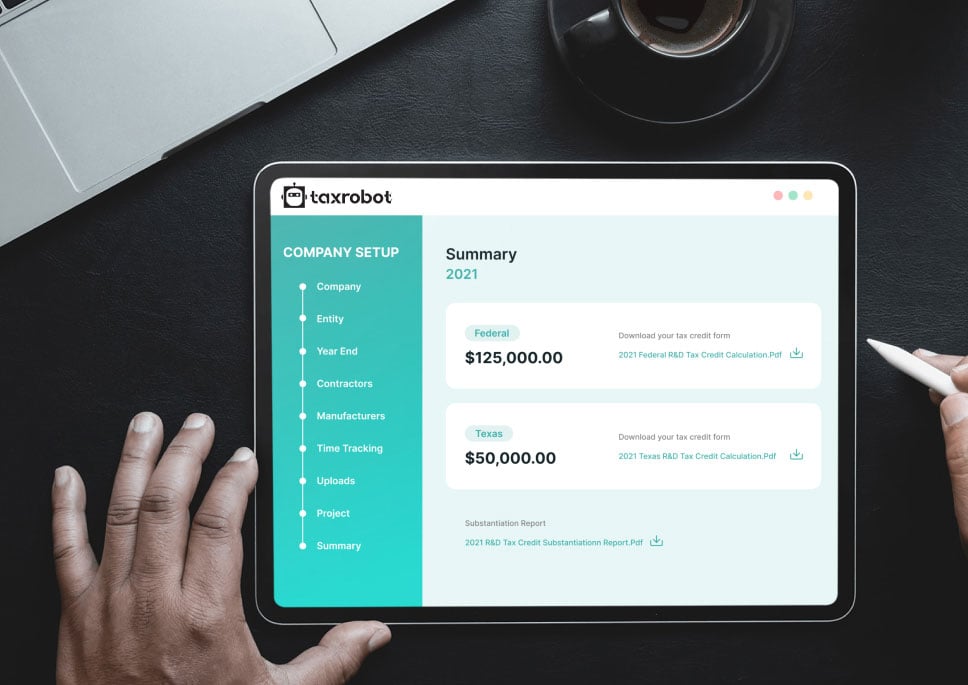Ohio R&D Tax Credit
Welcome to TaxRobot, your dedicated partner for navigating the complexities of Research & Development (R&D) tax credits in Ohio. We’re here to help you understand, apply for, and maximize these valuable incentives.
Maximize your State Credits today!
Put the R&D tax credit process on autopilot.
Trusted By:








Ohio R&D Tax Credits
Discover your eligibility for Ohio R&D tax credits and supercharge your enterprise.
Understanding the R&D Tax Credit in Ohio
The R&D tax credit is a program initiated by the government to provide incentives for companies that expand their investments in research and development activities within the borders of the United States. The aim is to stimulate economic growth and innovation across various industries.
These credits can offer significant financial benefits for Ohio businesses engaged in qualifying research activities, including reduced tax liability and increased cash flow. However, understanding and effectively leveraging these credits can be complex. That’s where TaxRobot comes in.
Activities that Qualify for the Ohio R&D Tax Credit
The IRS utilizes a four-part assessment to ascertain if an endeavor is eligible for the R&D tax credit.
- Technological in nature: The activity should be based on the principles of disciplines like engineering, physics, chemistry, biology, or computer science.
- Elimination of Uncertainty: The activity must aim to remove uncertainty about developing or improving a product or process.
- Process of Experimentation: The activity must involve the evaluation of alternative solutions or approaches.
- Qualified Purpose: The activity must aim to create new or improved functionality, performance, reliability, or quality of a business component.
TaxRobot’s team of experts are skilled at identifying qualifying activities within your business operations.
Expenses that Qualify for the Ohio R&D Tax Credit
Qualified Research Expenses (QREs) are the costs directly associated with conducting qualifying research activities. These typically include:
- Wages for employees directly involved in, supervising, or supporting R&D activities.
- Supplies used during the R&D process.
- Contract research expenses paid to a third parties.
- Basic research payments made to outside entities.
Our team can help identify these qualifying expenses within your business to maximize your R&D tax credit.
Documentation for the Ohio R&D Tax Credit
Documentation is crucial when claiming the R&D tax credit. It serves as evidence of your company’s qualifying activities and expenses. Typical documentation includes:
- Project records
- Payroll records
- General ledger expense detail
- Organizational charts
- Project lists
At TaxRobot, we assist you in gathering and organizing the necessary documentation, ensuring a seamless claim process.
Contact us today for R&D Tax Consulting.
How Does TaxRobot Work?
Navigating the world of R&D tax credits can be complicated and time-consuming. That’s where TaxRobot steps in. Our AI-powered software simplifies the process into three easy steps:
- Provide Your Information: Start by giving us details about your company and its research and development (R&D) endeavors. Our advanced software will assist you throughout the process by asking questions to ensure we gather all the required information.
- Link Your Systems: Next, link TaxRobot to your accounting and payroll systems. Our software will then analyze your data, identifying qualifying activities and expenses based on the latest IRS guidelines. This ensures you claim all eligible credits without spending hours digging through paperwork.
- Receive Your Refund: Once our software has identified all eligible expenses, it calculates your potential R&D tax credit. You’ll receive a comprehensive report detailing your claim, ready to be submitted to the IRS. And if you ever face an audit, rest assured TaxRobot creates audit-proof documentation to support every claim.
The Future of R&D Tax Credit Processing
TaxRobot is more than just a tool. It’s a revolution in R&D tax credit processing. By combining cutting-edge AI technology with deep tax expertise, we’re making R&D tax credits accessible to businesses of all sizes.
Ready to see how much you could save? Contact us today, and let’s get started on maximizing your R&D tax credits.
Take a sneak peak

- Limited Time Offer
- Simple Onboarding
- Easy to Use
R&D Tax Credits FAQs
The four-part test as outlined in the Internal Revenue Code is used to determine qualified R&D activity.
The Four-Part Test
1). New Or Improved Business Component
Creation of a new product, process, formula, invention, software, or technique; or improving the performance, functionality, quality, or reliability of existing business component.
- Construction of new buildings or renovation of existing buildings
- Invention of a software application
- Manufacturing of a new product or the improvement of the production process for an existing product
- Creation of design documentation
2). Technological In Nature
The activity fundamentally relies on principles of the physical or biological sciences, engineering, or computer science. A taxpayer does not need to obtain information that exceeds, expands or refines the common knowledge of skilled professionals in a particular field.
- Physics (relationship between mass, density and volume; loading as the
result of gravitational attraction) - Engineering (mechanical, electrical, civil, chemical)
- Computer science (theory of computation and design of computational systems)
3). Elimination Of Uncertainty
Uncertainty exists if the information available to the taxpayer does not establish the capability or method for developing or improving the business component, or the appropriate design of the business component.
- The capability of a manufacturer to create a part within the specified tolerances
- The appropriate method of overcoming unsuitable soil conditions during construction
- The appropriate software design to meet quality and volatility requirements
4). Process Of Experimentation
A process designed to evaluate one or more alternatives to achieve a result where the capability or method of achieving that result, or the appropriate design of that result, is uncertain as of the beginning of the taxpayer’s research activities.
- Systematic process of trial and error
- Evaluating alternative means and methods
- Computer modeling or simulation Prototyping Testing
The R&D tax credit is one of the most misunderstood tax incentives available. Considering the myriad of industries and activities that legally qualify for the credit, the term “research and development” is a misnomer. Additionally, the R&D tax credit requires specialized knowledge and technology to identify and calculate the incentive properly.
Companies of various industries are unaware that they are eligible to claim the R&D tax credit. Under the Internal Revenue Code’s definition of R&D, many common activities qualify. You can get tax benefits for industries including software, technology, architecture, engineering, construction, manufacturing, and more.
The R&D tax credit can be claimed for all open tax years. Generally, open tax years include the prior three tax years due to the statute of limitations period. In certain circumstances, the law allows businesses to claim the R&D tax credit for an extended period of time. It is common for companies to amend previous tax years to claim this benefit and reduce the maximum amount of tax liability.
Partnerships and S corporations must file this form to claim the credit. The credit will flow from the Form 6765, to the Schedule K-1, to the Form 3800 on the individual’s tax return. For individuals receiving this credit that have ownership interest in a partnership or S corporation, Form 6765 is not required on the individual return.
Individuals claiming this credit can report the credit directly on Form 3800, General Business Credit if their only source for the credit is a partnership, S corporation, estate, or trust. Otherwise, Form 6765 must be filed with the individual’s tax return (e.g. sole proprietorship).
For tax years prior to 2016, the credit can be used to reduce the taxpayer’s regular tax liability down to the tentative minimum tax. The credit cannot be used to offset alternative minimum tax. Beginning in tax year 2016, eligible small businesses have expanded utilization for the credit. For these eligible small businesses, the regular tax liability can offset alternative minimum tax using the “25/25” rule.
What our customers have to say
I highly recommend TaxRobot to anyone considering an R&D Tax Credit software to complete their analysis.

We decided to switch to TaxRobot… Best decision we’ve ever made. More affordable, and less complicated.

I couldn’t believe how easy it was! In under an hour, we saved enough money to hire a new employee.
